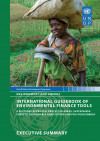The International Guidebook of Environmental Finance Tools provides guidance on developing and implementing the most commonly used, widely applicable, and potentially high-impact environmental finance tools. It aims to define and analyse the primary tools that are already in use and that can be applied globally to advance sustainable development. The tools explored in the Guidebook have been successfully applied to protect the environment and promote pro-poor and predominantly rural development. They were identified through a review of over one hundred environmental finance case studies from over thirty developing countries across four sectors: pro-poor energy, protected areas, sustainable agriculture and sustainable forestry.
- Benin
- Botswana
- Burkina Faso
- Burundi
- Cabo Verde
- Cameroon
- Comoros
- Congo
- Côte d'Ivoire
- Djibouti
- Egypt
- Eswatini
- Gabon
- Ghana
- Guinea
- Guinea Bissau
- Kenya
- Lesotho
- Malawi
- Mali
- Mauritania
- Mauritius
- Morocco
- Mozambique
- Namibia
- Nigeria
- Rwanda
- Sao Tome and Principe
- Senegal
- Seychelles
- Sierra Leone
- South Sudan
- Tanzania
- The Democratic Republic of the Congo
- The Gambia
- Togo
- Tunisia
- Uganda
- Zambia
